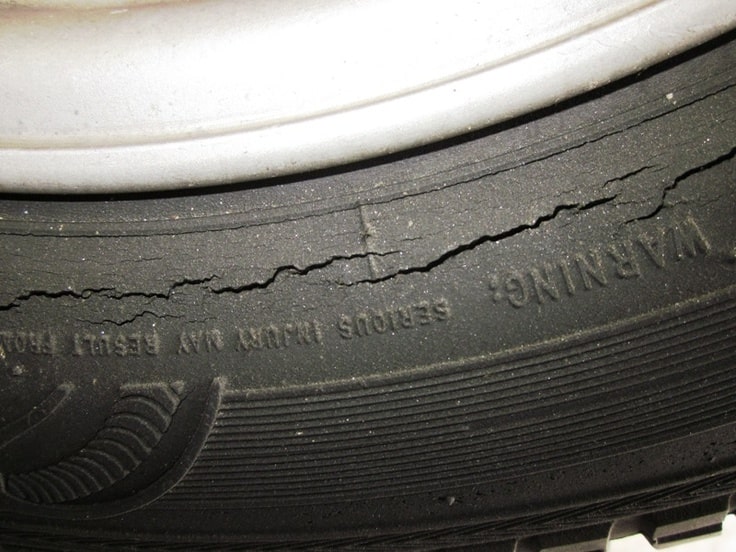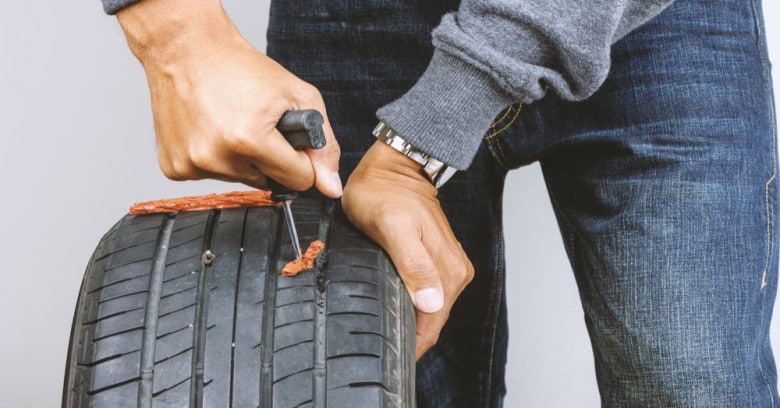How frustrating when you are driving, and you suddenly find a tiny hole in the sidewall of your tires? This unexpected incident makes you stop your journey. Using a patch will be the first thing you want to do in this situation (in case, you don’t have a spare tire or your tire is still new). However, patching sidewall of tire will be more complicated compared to patching a tire in other positions. Can you patch a tire sidewall? Our article will give extensive insights to explain this problem.
Contents
What Are Tire Sidewalls?
If you are not familiar with the term “sidewall” and don’t identify exactly the position of this component on your tires. We will go over this to give you basic knowledge about the very important part of your car. It’s crucial that you first can locate this section. You will find the sidewall in the position between the rims and hubcaps, and the tread. Sidewalls are usually marked in the form of numbers and brand names. This makes the sidewalls quite noticeable – especially when you choose a new tire.
One of the key functions of sidewalls is to serve as a decal to display all the metrics of your tire: tire type, aspect ratio, speed rating, load index…It can convey an entire production history with a simple combination of letters and numbers. If you understand these signs, they can provide you with all the information you need to know about the model. Operating as a covering, tire sidewalls help to increase the strength and stability of your tires. Besides these benefits, the sidewall keeps the body of the vehicle protected and limits air from escaping. Some sidewalls of the tire may contain extra components to increase lateral stability.

Can You Patch A Tire Sidewall?
One day, you just realize there is a nail or any sharp object that made a hole in the tire sidewall, and this tire can’t hold the air anymore. And your tires are still in good condition and it will be wasteful when you replace the tire with a new one. But it’s worse when you hear that many experts do not recommend patching a tire sidewall for safety reasons. The question: Is it possible to seal up the puncture on a tire sidewall? In the short term, the answer is “Yes” but in the long term, you shouldn’t. It means that you can use a patched tire in an emergency but you shouldn’t keep that tire for daily use, it should be moved to the spare tire location or recycled for other purposes.
Why is it not recommended for tire sidewall repair? Tire sidewalls are designed for maximum ductility, and that is what makes them incompatible with the adhesion of internal patches or self-plugs. Besides being relatively thin and flexible, this part transmits all the car’s power to the road surface. For years, sidewall damage has become a fatal blow to any vehicle. Suppose you don’t want to have an unexpected blowout at high-speed. To be safe, you should replace your tires when detecting any hole in the sidewall.
Driving a car too long with damage in the sidewall will decrease your speed, causing the feeling of vibration. However, in some emergency situations, you can’t replace your tires. If a very small puncture is from a nail or construction stapler, you can fix it by installing an inner tube. Patching a tire sidewall is just a temporary method, so you only should use this remedy until you reach the nearest auto repair center.
How Close To Sidewall Can A Tire Be Patched?
This is a very common question. When can you patch a hole in your tire sidewall? Repair must be performed by removing the tire from the rim/wheel assembly to perform a complete inspection to assess all damage that may be presented. Normally, patching a tire is only limited to only the tread area.
Although the sidewall is not an ideal position to apply a patch. You can patch any hole that is less than half an inch from the tip of the inner steel belt on the shoulder or sidewall. It means that any puncture in the tire sidewall a size that is less than 1/2 inch from the starting point of the inner steel belt couldn’t be patched. When can you not patch a tire? Puncture injury can not be greater than 1/4 inch (6mm) in diameter. Many experts don’t recommend making repairs where the injury damage extends into the shoulder/belt edge area or where the puncture extends at an angle into the shoulder area.
>> Related posts: Four Tire Sidewall Repair Hacks All Drivers Should Know
How To Patch A Tire Sidewall?

If it’s possible to make a repair in the tire sidewall, how can we do this process? Compared to repairing the puncture to the tread, patching a hole in the sidewall may be a little challenging. Before making a patching process, you need to have a tire plug kit and prepare some tools like a screwdriver, hand gloves, tire jack, tire plugging tool, etc. We will brief implementation steps: Polish and clean the area around the puncture. Apply a thin layer of glue to the area around the puncture. Use the mushroom patch to bring out from the inside of the tire, and use the tight scissors to stick the tire patch firmly to the tire. Trim the excess end of the outside of the tire. Let’s find out the detailed steps:
Step 1: Remove car tires
To remove car tires, you need a specialized car tire-making machine. Although you can completely remove car tires manually, if done incorrectly, it will greatly affect the balance of the wheel. Using a machine helps to protect the steering wheel best, with sufficient impact force, to remove the tire gently and quickly.
Step 2: Locate the puncture
When the tire is removed from the rim, it will make it easy to check the hole and make sure the damage is not serious. After identifying the hole on the tire sidewalls, the next step you must do is to remove the foreign object causing the tire puncture if any. Let’s go ahead and get all the air out of your tire. The puncture needs to be smoothed so that it does not extend any further. Don’t forget to clean the surface area around the hole inside your tire to prepare for a new patch.
Step 3: Patch the application
In this step, you should try to keep the hole as small as possible by adding more glue and neatly and carefully push the little plug into the puncture to fill up (depending on the size of the hole on the tire sidewall, you will cut the plugs to be suitable). So take your time gently pushing this plug by using a small screwdriver to seal up the hole. And the actual glue will help to keep the plug in place. Once you put everything in the hole, to check the strength of the plug, you can use pliers to pull it out a little bit when you pull it, it creates a situation that is like a little mushroom effect.
Step 4: Pump air and inspect
After completing the above steps, the driver needs to wait about 10-15 minutes for the glue to dry and re-inflate the tires with an electric or hand pump. To ensure safety, drivers should not always drive after patching a tire sidewall but should monitor the condition of the tires within 12-24 hours. If air leaks are detected, you should not drive on the road, need to change new tires, or take other precautions.
>> Read more: How Long Can You Drive on a Patched Tire?
Final Thoughts: Can You Patch A Tire Sidewall?
You already had the answer to the question “Can you patch a tire sidewall?” It’s not a good idea and sometimes patching a tire sidewall can become fatal for your car. Replacing a new tire is always the best method at this time. However, in some cases where you don’t have a spare tire on hand and are driving in a remote area, tire patching can’t be a long-term solution, because the patches can fail anytime until your car reaches the repair center. We hope that through this article the concern about “patching a tire sidewall” is no longer a headache for you.



